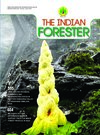Comparative Study of Wooded Angiospermic Diversity of the Two Protected Areas (Purna Wildlife Sanctuary and Jessore Wildlife Sanctuary) in Two Biogeographic Regions Of Gujarat, India
DOI:
https://doi.org/10.36808/if/2018/v144i7/130920Keywords:
PWS, JWS, Flora, Protected Area, Bio-Geographical Regions.Abstract
The wooded angiospermic plants have rendered very important role in the ecological equilibrium and livelihood to the forest dwellers. Its diversity, composition and richness varies from place to place as per geographical settings. The object of this study was to determine the diversity and composition in the wooded angiospermic plant in two Protected Areas viz., Purna Wildlife Sanctuary (PWS) and Jessore Wildlife Sanctuary (JWS) of two different bio-geographical zones of Gujarat state. The qualitative and quantitative study has been completed through transect and quadrate methods. The results revealed that both Protected Areas have floristic heterogeneity in their jurisdiction and the qualitative examination of the both the sanctuaries indicated that a total of 136 species of trees and 32 species of shrubs exist in the PWS. However, the JWS showed a total of 84 species of trees and 27species of shrubs in their jurisdiction which is fewer than PWS. The quantitative analysis also showed that the density, frequency and abundance of wooded angiospermic plants are higher in the PWS than JWS. The biodiversity indices have shown that the species richness of trees in the PWS and JWS is good. However, the shrub composition and richness have shown decline in both of the sanctuaries. The similarity and dissimilarity indices have shown that the tree species are more diverse (63%) than shrub species (37%) in the both of the Protected Areas. Due to two different bio-geographical zones present in the study area, it has its own unique but distinct vegetation composition and diversity.References
Anon. (2017). http://www.countrysideinfo.co.uk/simpsons.htm. Retrieved from http://www.countrysideinfo.co.uk.
Elzinga C.L., Salzer D.W. and Willoughby J.W. (1998). Measuring and Monitoring Plant Populations. Denver: U.S Department of Interior Bureau of land Management, 492pp. http;//www.mea.gov.in/india-at-galance.htm.
Knight D.H. (1975). A Phytosociological Analysisof Species rich Tropical Forest on Baro -Kolorado Island: Panama. Ecological Monographs, 45(3): 259-289.
Kumar S., Gupta N.K., Mahajan P.K. and Sikha D. (2015). Phytosociological Status Under Pink Cedar (Acrocarpus fraxinifolius Wight and Arn.). Indian Forester, 141(12): 1252-1256.
Lalfakwma Sahoo, U.K., Roy S., Vanlalhritpuia K. and Vanlalahluna P.C. (2009). Community compostion and Tree population structure in Undisturbed and Disturbed tropical Semievergreen Forest stands of North- East India. Appl. Ecol. Envoron. Res., 7(4): 303-318.
Menon A.R. and Balasubramanyan K. (1985). Species Relation Studies in Moist Decidous Forest of Trichur Forest Division (Kerala). KFRI Research Report 32. Kerala Forest Research Institute, Peechi, Thrissure.
Mishra R. (1968). Ecology work Book.India: Oxford and IHB Publisher, 241pp.
Panda P.C., Mahapatra A.K., Acharya P.K. and Debata A.K. (2013). Plant Diversity in Tropical Decidous Forest of Estern Ghats, India: A Landscape Level Assesmemnt. Inter. J. Biodiversity and Conservation, 5(10): 625-639.
Pandey C.N., Patel S.P., Chavan S., Salvi H., Patel B.H., Vyas R. and Aiyadurai A. (2004). The status of Biodiversity in Purna Wildlife Sanctuary. Gujarat Ecological Education and Research Foundation . Gandhinagra: Gujarat Forest Department, 87pp.
Pandey C.N., Patel B.H., Salvi H., Chavan S., Damor C. and Patel N. (2009). The Status of Boidiversity Study of Jessore Wildlife Sanctuary. Gandhinagar: GEER Foundation, 187pp.
Patel D.N. (2003). Ecology, conservation and sustainable management of Jessore sloth bear sanctuary. Department of Lifesciences . Bhavnagar University, 189 pp.
Phillips E.A. (1959). Methods of Vegetation Study. Henry Hilt. and Co. Inc.
Rana K.G.and Nagar P.S. (2017). Diversity and Distribution of Endemic Angiosperms in Gujarat state. Inter. J. Advance Research, 5(6): 730-758.
Raunkiaer C. (1934). The Life Form of Plants and statistical Geography. Claredon Oxford.
Rodgers W.A. and Panwar H.S. (1988). Planning a Wildlife Protected Area in India (Vol. 1 and 2). Dehradun: Wildlife Institute of India.
Singh J.S., Singh S.P., Saxena A.K. and Rawat Y.S. (1984). The Forest Vegetation of Silent Valley, India. Tropical Rain Forest (Chaidwick, A.C. and S.L Sutton, eds). The Leeds Symposium. Leeds Philosophical and Litterary Society (pp. 25-52), Leeds, England.
Tadvi D.S. (2013). Floristic Diversity of Dangs Gujarat. The Maharaja Sayajirao University, Department of Botany, Vadodara, 84pp.
Vishalakshi N. (1995). Vegetation Analysis of two Tropical dry evergreen forest in Southern India. Tropical Ecology, 36 (1): 117-127.
Downloads
Downloads
Published
How to Cite
Issue
Section
License
Unless otherwise stated, copyright or similar rights in all materials presented on the site, including graphical images, are owned by Indian Forester.





